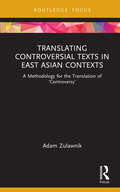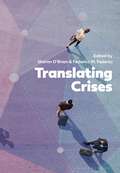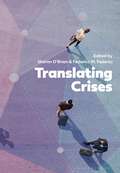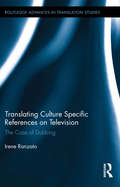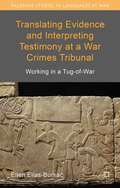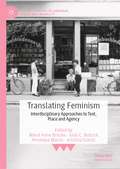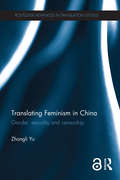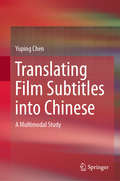- Table View
- List View
Translating Chinese Culture: The process of Chinese--English translation
by Valerie Pellatt Eric T. Liu Yalta Ya-Yun ChenTranslating Chinese Culture is an innovative and comprehensive coursebook which addresses the issue of translating concepts of culture. Based on the framework of schema building, the course offers helpful guidance on how to get inside the mind of the Chinese author, how to understand what he or she is telling the Chinese-speaking audience, and how to convey this to an English speaking audience. A wide range of authentic texts relating to different aspects of Chinese culture and aesthetics are presented throughout, followed by close reading discussions of how these practices are executed and how the aesthetics are perceived among Chinese artists, writers and readers. Also taken into consideration are the mode, audience and destination of the texts. Ideas are applied from linguistics and translation studies and each discussion is reinforced with a wide variety of practical and engaging exercises. Thought-provoking yet highly accessible, Translating Chinese Culture will be essential reading for advanced undergraduates and postgraduate students of Translation and Chinese Studies. It will also appeal to a wide range of language studies and tutors through its stimulating discussion of the principles and purposes of translation.
Translating Chinese Fiction: Multiple Voices and Cognitive Translatology
by Tan YeshengDrawing on the cognitive translatological paradigm, this book introduces a situation-embedded cognitive construction model of translation and explores the thinking portfolios of British and American sinologists-cum-translators to re-examine their multiple voices and cognition in translating Chinese fiction.By placing sinologists-cum-translators in the same discourse space, the study transcends the limitations of previous case studies and offers a comprehensive cognitive panorama of how Chinese novels are rendered. The author explores the challenges and difficulties of translating Chinese fiction from the insider perspectives of British and American sinologists, and cross-validates their multiple voices by aligning them with cross-cultural communication scenarios. Based on the cognitive construction model of translation, the book provides a systematic review of the translation thoughts and ideas of the community of sinologists in terms of linguistic conventions, narrative styles, contextual and cultural frames, readership categories and metaphorical models of translation. It envisions a new research path to enhance empirical research on translators' cognition in a dynamic translation ecosystem. The title will be an essential read for students and scholars of translation studies and Chinese studies. It will also appeal to translators and researchers interested in cognitive stylistics, literary studies and intercultural communication studies.
Translating Chinese Fiction: Multiple Voices and Cognitive Translatology
by Tan YeshengDrawing on the cognitive translatological paradigm, this book introduces a situation-embedded cognitive construction model of translation and explores the thinking portfolios of British and American sinologists-cum-translators to re-examine their multiple voices and cognition in translating Chinese fiction.By placing sinologists-cum-translators in the same discourse space, the study transcends the limitations of previous case studies and offers a comprehensive cognitive panorama of how Chinese novels are rendered. The author explores the challenges and difficulties of translating Chinese fiction from the insider perspectives of British and American sinologists, and cross-validates their multiple voices by aligning them with cross-cultural communication scenarios. Based on the cognitive construction model of translation, the book provides a systematic review of the translation thoughts and ideas of the community of sinologists in terms of linguistic conventions, narrative styles, contextual and cultural frames, readership categories and metaphorical models of translation. It envisions a new research path to enhance empirical research on translators' cognition in a dynamic translation ecosystem. The title will be an essential read for students and scholars of translation studies and Chinese studies. It will also appeal to translators and researchers interested in cognitive stylistics, literary studies and intercultural communication studies.
Translating Controversial Texts in East Asian Contexts: A Methodology for the Translation of ‘Controversy’ (Routledge Advances in Translation and Interpreting Studies)
by Adam ZulawnikZulawnik focuses on the broad concept of ‘controversy’ and issues pertaining to the translation of politically and historically controversial texts in East Asia. The research methodology is exemplified through a case study in the form of the author’s translation of the best-selling Japanese graphic novel (manga) Manga Kenkanryū (Hate Hallyu: The Comic) by Sharin Yamano (2005), a work that has been problematised as an attack on South Korean culture and the Korean Wave. Issues analysed and discussed in the research include translation risk, ethics, a detailed methodology for the translation of so-called controversial texts exemplified through numerous thematically divided examples from the translation of the chosen Japanese text, as well as examples from a Korean language equivalent (Manhwa Hyeomillyu – Hate Japanese Wave), and definition and contextualisation of the concept of ‘controversy’. There has been limited research in the field of translation studies, which seeks to exemplify potential pragmatic approaches for the translation of politically-charged texts, particularly in multi-modal texts such as the graphic novel. It is hoped that Zulawnik’s research will serve both as a valuable source when examining South Korea–Japan relations and a theoretical and methodological base for further research and the development of an online augmented translation space with devices specifically suited for the translation of multi-modal texts such as – but not limited to – graphic novels and visual encyclopaedias.
Translating Controversial Texts in East Asian Contexts: A Methodology for the Translation of ‘Controversy’ (Routledge Advances in Translation and Interpreting Studies)
by Adam ZulawnikZulawnik focuses on the broad concept of ‘controversy’ and issues pertaining to the translation of politically and historically controversial texts in East Asia. The research methodology is exemplified through a case study in the form of the author’s translation of the best-selling Japanese graphic novel (manga) Manga Kenkanryū (Hate Hallyu: The Comic) by Sharin Yamano (2005), a work that has been problematised as an attack on South Korean culture and the Korean Wave. Issues analysed and discussed in the research include translation risk, ethics, a detailed methodology for the translation of so-called controversial texts exemplified through numerous thematically divided examples from the translation of the chosen Japanese text, as well as examples from a Korean language equivalent (Manhwa Hyeomillyu – Hate Japanese Wave), and definition and contextualisation of the concept of ‘controversy’. There has been limited research in the field of translation studies, which seeks to exemplify potential pragmatic approaches for the translation of politically-charged texts, particularly in multi-modal texts such as the graphic novel. It is hoped that Zulawnik’s research will serve both as a valuable source when examining South Korea–Japan relations and a theoretical and methodological base for further research and the development of an online augmented translation space with devices specifically suited for the translation of multi-modal texts such as – but not limited to – graphic novels and visual encyclopaedias.
Translating Crises
by Sharon O’Brien and Federico M. FedericiTranslating and interpreting in crises is emotionally and cognitively demanding, with crisis communication in intercultural and multilingual disaster settings relying on a multitude of cross-cultural mediators and ever-emerging new technologies. This volume explores the challenges and demands involved in translating crises and the ways in which people, technologies and organisations look for effective, impactful solutions to the communicative problems.Problematising the major issues, but also providing solutions and recommendations, chapters reflect on and evaluate the role of translation and interpreting in crisis settings. Covering a diverse range of situations from across the globe, such as health emergencies, severe weather events, earthquakes, terrorist attacks, conflicts, and mass migration, this volume analyses practices and investigates the effectiveness of current approaches and communication strategies. The book considers perspectives, from interpreting specialists, educators, emergency doctors, healthcare professionals, psychologists, and members of key NGOs, to reflect the complex and multifaceted nature of crisis communication. Placing an emphasis on lessons learnt and innovative solutions, Translating Crises points the way towards more effective multilingual emergency communication in future crises.
Translating Crises
Translating and interpreting in crises is emotionally and cognitively demanding, with crisis communication in intercultural and multilingual disaster settings relying on a multitude of cross-cultural mediators and ever-emerging new technologies. This volume explores the challenges and demands involved in translating crises and the ways in which people, technologies and organisations look for effective, impactful solutions to the communicative problems.Problematising the major issues, but also providing solutions and recommendations, chapters reflect on and evaluate the role of translation and interpreting in crisis settings. Covering a diverse range of situations from across the globe, such as health emergencies, severe weather events, earthquakes, terrorist attacks, conflicts, and mass migration, this volume analyses practices and investigates the effectiveness of current approaches and communication strategies. The book considers perspectives, from interpreting specialists, educators, emergency doctors, healthcare professionals, psychologists, and members of key NGOs, to reflect the complex and multifaceted nature of crisis communication. Placing an emphasis on lessons learnt and innovative solutions, Translating Crises points the way towards more effective multilingual emergency communication in future crises.
Translating Culture Specific References on Television: The Case of Dubbing (Routledge Advances in Translation and Interpreting Studies)
by Irene RanzatoTranslating Culture Specific References on Television provides a model for investigating the problems posed by culture specific references in translation, drawing on case studies that explore the translational norms of contemporary Italian dubbing practices. This monograph makes a distinctive contribution to the study of audiovisual translation and culture specific references in its focus on dubbing as opposed to subtitling, and on contemporary television series, rather than cinema. Irene Ranzato’s research involves detailed analysis of three TV series dubbed into Italian, drawing on a corpus of 95 hours that includes nearly 3,000 CSR translations. Ranzato proposes a new taxonomy of strategies for the translation of CSRs and explores the sociocultural, pragmatic and ideological implications of audiovisual translation for the small screen.
Translating Culture Specific References on Television: The Case of Dubbing (Routledge Advances in Translation and Interpreting Studies)
by Irene RanzatoTranslating Culture Specific References on Television provides a model for investigating the problems posed by culture specific references in translation, drawing on case studies that explore the translational norms of contemporary Italian dubbing practices. This monograph makes a distinctive contribution to the study of audiovisual translation and culture specific references in its focus on dubbing as opposed to subtitling, and on contemporary television series, rather than cinema. Irene Ranzato’s research involves detailed analysis of three TV series dubbed into Italian, drawing on a corpus of 95 hours that includes nearly 3,000 CSR translations. Ranzato proposes a new taxonomy of strategies for the translation of CSRs and explores the sociocultural, pragmatic and ideological implications of audiovisual translation for the small screen.
Translating Cultures: An Introduction for Translators, Interpreters and Mediators
by David KatanAs the 21st century gets into stride so does the call for a discipline combining culture and translation. This second edition of Translating Cultures retains its original aim of putting some rigour and coherence into these fashionable words and lays the foundation for such a discipline. This edition has not only been thoroughly revised, but it has also been expanded. In particular, a new chapter has been added which focuses specifically on training translators for translational and intercultural competencies. The core of the book provides a model for teaching culture to translators, interpreters and other mediators. It introduces the reader to current understanding about culture and aims to raise awareness of the fundamental role of culture in constructing, perceiving and translating reality. Culture is perceived throughout as a system for orienting experience, and a basic presupposition is that the organization of experience is not 'reality', but rather a simplified model and a 'distortion' which varies from culture to culture. Each culture acts as a frame within which external signs or 'reality' are interpreted. The approach is interdisciplinary, taking ideas from contemporary translation theory, anthropology, Bateson's logical typing and metamessage theories, Bandler and Grinder's NLP meta-model theory, and Hallidayan functional grammar. Authentic texts and translations are offered to illustrate the various strategies that a cultural mediator can adopt in order to make the different cultural frames he or she is mediating between more explicit.
Translating Cultures: An Introduction for Translators, Interpreters and Mediators
by David KatanAs the 21st century gets into stride so does the call for a discipline combining culture and translation. This second edition of Translating Cultures retains its original aim of putting some rigour and coherence into these fashionable words and lays the foundation for such a discipline. This edition has not only been thoroughly revised, but it has also been expanded. In particular, a new chapter has been added which focuses specifically on training translators for translational and intercultural competencies. The core of the book provides a model for teaching culture to translators, interpreters and other mediators. It introduces the reader to current understanding about culture and aims to raise awareness of the fundamental role of culture in constructing, perceiving and translating reality. Culture is perceived throughout as a system for orienting experience, and a basic presupposition is that the organization of experience is not 'reality', but rather a simplified model and a 'distortion' which varies from culture to culture. Each culture acts as a frame within which external signs or 'reality' are interpreted. The approach is interdisciplinary, taking ideas from contemporary translation theory, anthropology, Bateson's logical typing and metamessage theories, Bandler and Grinder's NLP meta-model theory, and Hallidayan functional grammar. Authentic texts and translations are offered to illustrate the various strategies that a cultural mediator can adopt in order to make the different cultural frames he or she is mediating between more explicit.
Translating Cultures: An Introduction for Translators, Interpreters and Mediators
by David Katan Mustapha TaibiThis bestselling coursebook introduces current understanding about culture and provides a model for teaching culture to translators, interpreters and other mediators. The approach is interdisciplinary, with theory from Translation Studies and beyond, while authentic texts and translations illustrate intercultural issues and strategies adopted to overcome them. This new (third) edition has been thoroughly revised to update scholarship and examples and now includes new languages such as Arabic, Chinese, German, Japanese, Russian and Spanish, and examples from interpreting settings. This edition revisits the chapters based on recent developments in scholarship in intercultural communication, cultural mediation, translation and interpreting. It aims to achieve a more balanced representation of written and spoken communication by giving more attention to interpreting than the previous editions, especially in interactional settings. Enriched with discussion of key recent scholarly contributions, each practical example has been revisited and/ or updated. Complemented with online resources, which may be used by both teachers and students, this is the ideal resource for all students of translation and interpreting, as well as any reader interested in communication across cultural divides. Additional resources are available on the Routledge Translation Studies Portal: http://routledgetranslationstudiesportal.com/
Translating Cultures: An Introduction for Translators, Interpreters and Mediators
by David Katan Mustapha TaibiThis bestselling coursebook introduces current understanding about culture and provides a model for teaching culture to translators, interpreters and other mediators. The approach is interdisciplinary, with theory from Translation Studies and beyond, while authentic texts and translations illustrate intercultural issues and strategies adopted to overcome them. This new (third) edition has been thoroughly revised to update scholarship and examples and now includes new languages such as Arabic, Chinese, German, Japanese, Russian and Spanish, and examples from interpreting settings. This edition revisits the chapters based on recent developments in scholarship in intercultural communication, cultural mediation, translation and interpreting. It aims to achieve a more balanced representation of written and spoken communication by giving more attention to interpreting than the previous editions, especially in interactional settings. Enriched with discussion of key recent scholarly contributions, each practical example has been revisited and/ or updated. Complemented with online resources, which may be used by both teachers and students, this is the ideal resource for all students of translation and interpreting, as well as any reader interested in communication across cultural divides. Additional resources are available on the Routledge Translation Studies Portal: http://routledgetranslationstudiesportal.com/
Translating Dissent: Voices From and With the Egyptian Revolution (Critical Perspectives on Citizen Media)
by Mona Baker*Written by the winners of the Inttranews Linguists of the Year award for 2016!* Discursive and non-discursive interventions in the political arena are heavily mediated by various acts of translation that enable protest movements to connect across the globe. Focusing on the Egyptian experience since 2011, this volume brings together a unique group of activists who are able to reflect on the complexities, challenges and limitations of one or more forms of translation and its impact on their ability to interact with a variety of domestic and global audiences. Drawing on a wide range of genres and modalities, from documentary film and subtitling to oral narratives, webcomics and street art, the 18 essays reveal the dynamics and complexities of translation in protest movements across the world. Each unique contribution demonstrates some aspect of the interdependence of these movements and their inevitable reliance on translation to create networks of solidarity. The volume is framed by a substantial introduction by Mona Baker and includes an interview with Egyptian activist and film-maker, Philip Rizk. With contributions by scholars and artists, professionals and activists directly involved in the Egyptian revolution and other movements, Translating Dissent will be of interest to students of translation, intercultural studies and sociology, as well as the reader interested in the study of social and political movements. Online materials, including links to relevant websites and videos, are available at http://www.routledge.com/cw/baker. Additional resources for Translation and Interpreting Studies are available on the Routledge Translation Studies Portal: http://cw.routledge.com/textbooks/translationstudies.
Translating Dissent: Voices From and With the Egyptian Revolution (Critical Perspectives on Citizen Media)
by Mona Baker*Written by the winners of the Inttranews Linguists of the Year award for 2016!* Discursive and non-discursive interventions in the political arena are heavily mediated by various acts of translation that enable protest movements to connect across the globe. Focusing on the Egyptian experience since 2011, this volume brings together a unique group of activists who are able to reflect on the complexities, challenges and limitations of one or more forms of translation and its impact on their ability to interact with a variety of domestic and global audiences. Drawing on a wide range of genres and modalities, from documentary film and subtitling to oral narratives, webcomics and street art, the 18 essays reveal the dynamics and complexities of translation in protest movements across the world. Each unique contribution demonstrates some aspect of the interdependence of these movements and their inevitable reliance on translation to create networks of solidarity. The volume is framed by a substantial introduction by Mona Baker and includes an interview with Egyptian activist and film-maker, Philip Rizk. With contributions by scholars and artists, professionals and activists directly involved in the Egyptian revolution and other movements, Translating Dissent will be of interest to students of translation, intercultural studies and sociology, as well as the reader interested in the study of social and political movements. Online materials, including links to relevant websites and videos, are available at http://www.routledge.com/cw/baker. Additional resources for Translation and Interpreting Studies are available on the Routledge Translation Studies Portal: http://cw.routledge.com/textbooks/translationstudies.
Translating Early Modern China: Illegible Cities (Global Asias)
by Carla NappiThe history of China, as any history, is a story of and in translation. Translating Early Modern China tells the story of translation in China to and from non-European languages and Latin between the fourteenth and the nineteenth centuries, and primarily in the Ming and Qing dynasties. Each chapter finds a particular translator resurrected from the past to tell the story of a text that helped shape the history of translation in China. In Chinese, Mongolian, Manchu, Latin, and more, these texts helped to make the Chinese language what it was at different points in its history. This volume explores what the form of an academic history book might look like by playing with fictioning as part of the historian's craft. The book's many stories—of glossaries and official Ming translation bureaus, of bilingual Ming Chinese-Mongolian language primers, of the first Latin grammar of Manchu, of a Qing Manchu conversation manual, of a collection of Manchu poems by a Qing translator—serve as case studies that open out into questions of language and translation in China's past, of the use of fiction as a historian's tool, and of the ways that translation creates language.
Translating Early Modern China: Illegible Cities (Global Asias)
by Carla NappiThe history of China, as any history, is a story of and in translation. Translating Early Modern China tells the story of translation in China to and from non-European languages and Latin between the fourteenth and the nineteenth centuries, and primarily in the Ming and Qing dynasties. Each chapter finds a particular translator resurrected from the past to tell the story of a text that helped shape the history of translation in China. In Chinese, Mongolian, Manchu, Latin, and more, these texts helped to make the Chinese language what it was at different points in its history. This volume explores what the form of an academic history book might look like by playing with fictioning as part of the historian's craft. The book's many stories—of glossaries and official Ming translation bureaus, of bilingual Ming Chinese-Mongolian language primers, of the first Latin grammar of Manchu, of a Qing Manchu conversation manual, of a collection of Manchu poems by a Qing translator—serve as case studies that open out into questions of language and translation in China's past, of the use of fiction as a historian's tool, and of the ways that translation creates language.
Translating Europe in ?lfric's Lives of Saints (Oxford English Monographs)
by Luisa OstacchiniTranslating Europe in ?lfric's 'Lives of Saints' is the first study of the representation of European peoples, places, and geographies in the Lives of Saints, one of early medieval England's most famed works. It examines the Lives of Saints as a unified collection whose various items work cumulatively and concurrently to provide audiences with teachings far beyond the scope of an individual homily or saints' life. In doing so, it demonstrates that ?lfric's European characters and settings served not merely as a convenient skeleton on which to frame his hagiographical narratives, but rather lay at the heart of his didactic praxis and pedagogic aims. Luisa Ostacchini systematically compares each of the 30 plus items that comprise ?lfric's Lives of Saints to their Latin sources and to one another to highlight previously unnoticed patterns and formulae within collection. In so doing, she demonstrates that ?lfric's interest in community was both inward and outward looking: he sought on the one hand to situate England within the wider Christian world, and on the other hand to promote the internal unity of the English kingdom and the reformed monastic establishment. This book sheds new light on the ways that ?lfric wrote about the Christian world and England's place within it, and further illuminates of the didactic praxis and ideology of one of the most influential and significant authors of the early medieval period. Luisa Ostacchini is a college lecturer at St John's College, Oxford, where she teaches Old and Middle English literature.
Translating Europe in ?lfric's Lives of Saints (Oxford English Monographs)
by Luisa OstacchiniTranslating Europe in ?lfric's 'Lives of Saints' is the first study of the representation of European peoples, places, and geographies in the Lives of Saints, one of early medieval England's most famed works. It examines the Lives of Saints as a unified collection whose various items work cumulatively and concurrently to provide audiences with teachings far beyond the scope of an individual homily or saints' life. In doing so, it demonstrates that ?lfric's European characters and settings served not merely as a convenient skeleton on which to frame his hagiographical narratives, but rather lay at the heart of his didactic praxis and pedagogic aims. Luisa Ostacchini systematically compares each of the 30 plus items that comprise ?lfric's Lives of Saints to their Latin sources and to one another to highlight previously unnoticed patterns and formulae within collection. In so doing, she demonstrates that ?lfric's interest in community was both inward and outward looking: he sought on the one hand to situate England within the wider Christian world, and on the other hand to promote the internal unity of the English kingdom and the reformed monastic establishment. This book sheds new light on the ways that ?lfric wrote about the Christian world and England's place within it, and further illuminates of the didactic praxis and ideology of one of the most influential and significant authors of the early medieval period. Luisa Ostacchini is a college lecturer at St John's College, Oxford, where she teaches Old and Middle English literature.
Translating Evidence and Interpreting Testimony at a War Crimes Tribunal: Working in a Tug-of-War (Palgrave Studies in Languages at War)
by Ellen Elias-BursacHow can defendants be tried if they cannot understand the charges being raised against them? Can a witness testify if the judges and attorneys cannot understand what the witness is saying? Can a judge decide whether to convict or acquit if she or he cannot read the documentary evidence? The very viability of international criminal prosecution and adjudication hinges on the massive amounts of translation and interpreting that are required in order to run these lengthy, complex trials, and the procedures for handling the demands facing language services. This book explores the dynamic courtroom interactions in the International Criminal Tribunal for the Former Yugoslavia in which witnesses testify through an interpreter about translations, attorneys argue through an interpreter about translations and the interpreting, and judges adjudicate on the interpreted testimony and translated evidence.
Translating Feminism: Interdisciplinary Approaches to Text, Place and Agency (Palgrave Studies in Language, Gender and Sexuality)
by Maud Anne Bracke Julia C. Bullock Penelope Morris Kristina SchulzThis edited book addresses the diversity across time and space of the sites, actors and practices of feminist translation from 1945-2000. The contributors examine what happens when a politically motivated text is translated linguistically and culturally, the translators and their aims, and the strategies employed when adapting texts to locally resonating discourses. The collection aims to answer these questions through case studies and a conceptual rethinking of the process of politically engaged translation, considering not only trained translators and publishers, but also feminist activists and groups, NGOs and writers. The book will be of interest to students and researchers in the fields of translation studies, gender/women's studies, literature and feminist history.
Translating Feminism in China: Gender, Sexuality and Censorship (Routledge Advances in Translation and Interpreting Studies)
by Zhongli YuThis book explores translation of feminism in China through examining several Chinese translations of two typical feminist works: The Second Sex (TSS, Beauvoir 1949/1952) and The Vagina Monologues (TVM, Ensler 1998). TSS exposes the cultural construction of woman while TVM reveals the pervasiveness of sexual oppression toward women. The female body and female sexuality (including lesbian sexuality) constitute a challenge to the Chinese translators due to cultural differences and sexuality still being a sensitive topic in China. This book investigates from gender and feminist perspectives, how TSS and TVM have been translated and received in China, with special attention to how the translators meet the challenges. Since translation is the gateway to the reception of feminism, an examination of the translations should reveal the response to feminism of the translator as the first reader and gatekeeper, and how feminism is translated both ideologically and technically in China. The translators’ decisions are discussed within the social, historical, and political contexts. Translating Feminism in China discusses, among other issues: Feminist Translation: Practice, Theory, and Studies Translating the Female Body and Sexuality Translating Lesbianism Censorship, Sexuality, and Translation This book will be relevant to postgraduate students and researchers of translation studies. It will also interest academics interested in feminism, gender studies and Chinese literature and culture. Zhongli Yu is Assistant Professor of Translation Studies at the University of Nottingham Ningbo China (UNNC).
Translating Feminism in China: Gender, Sexuality and Censorship (Routledge Advances in Translation and Interpreting Studies)
by Zhongli YuThis book explores translation of feminism in China through examining several Chinese translations of two typical feminist works: The Second Sex (TSS, Beauvoir 1949/1952) and The Vagina Monologues (TVM, Ensler 1998). TSS exposes the cultural construction of woman while TVM reveals the pervasiveness of sexual oppression toward women. The female body and female sexuality (including lesbian sexuality) constitute a challenge to the Chinese translators due to cultural differences and sexuality still being a sensitive topic in China. This book investigates from gender and feminist perspectives, how TSS and TVM have been translated and received in China, with special attention to how the translators meet the challenges. Since translation is the gateway to the reception of feminism, an examination of the translations should reveal the response to feminism of the translator as the first reader and gatekeeper, and how feminism is translated both ideologically and technically in China. The translators’ decisions are discussed within the social, historical, and political contexts. Translating Feminism in China discusses, among other issues: Feminist Translation: Practice, Theory, and Studies Translating the Female Body and Sexuality Translating Lesbianism Censorship, Sexuality, and Translation This book will be relevant to postgraduate students and researchers of translation studies. It will also interest academics interested in feminism, gender studies and Chinese literature and culture. Zhongli Yu is Assistant Professor of Translation Studies at the University of Nottingham Ningbo China (UNNC).
Translating Film Subtitles into Chinese: A Multimodal Study
by Yuping ChenThis book examines three metafunction meanings in subtitle translation with three research foci, i.e., the main types of cross-modal interrelation, the primary function of semiotic interplay, and the key linguistic components influencing the subtitles. It goes beyond traditional textual analysis in translation studies; approaches subtitle translation from a multimodality standpoint; and breaks through the linguistic restraints on subtitling research by underscoring the role of semiotic interplay. In the field of multimodality, this book bridges subtitling and multimodality by investigating the interweaving relationships between different semiotic modes, and their corresponding impacts on subtitle translation.
Translating for Museums, Galleries and Heritage Sites (Translation Practices Explained)
by Robert NeatherIn any museum, gallery, or heritage site that wishes to engage with foreign-language visitors, translation is essential. Providing texts in foreign languages – whether for international visitors from different language cultures or for heritage speakers of local minority languages – is centrally important in enabling these visitors to make sense of what they see displayed. Yet despite this awareness, and a growing body of research in the field, there has hitherto been little available in the way of practical training in this area of translation. This book aims to help fill that need.Translating for Museums, Galleries and Heritage Sites focuses on the translation of interpretive and information texts, particularly in the museum context. After an initial introduction and an overview of key concepts in both museums and translation, it looks at three broad groupings of texts from the museum text system: fixed labels and wall panels, leaflets and other portable learning resources, and catalogues and guides, including a section on websites. It concludes with a call to place translation centre stage in museum, gallery, and heritage practice. The book will be of use as a coursebook for students at both undergraduate and postgraduate levels, and for practitioners in the sector, and is designed to be suitable for both individual and class-based learning.


